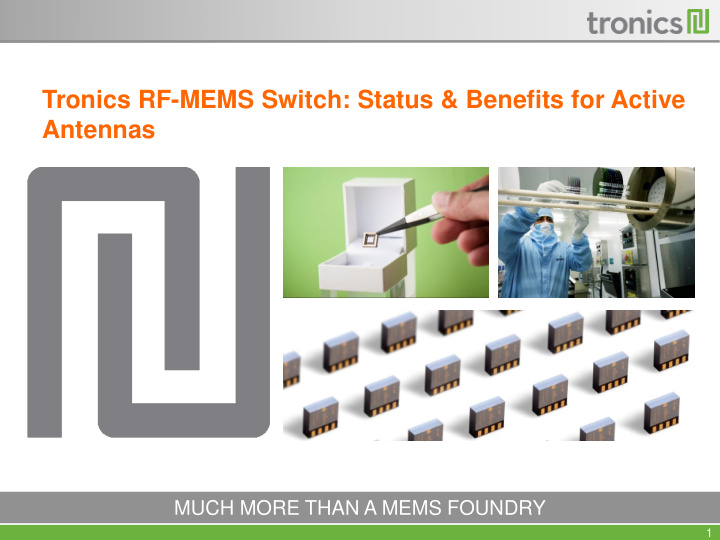



Tronics RF-MEMS Switch: Status & Benefits for Active Antennas MUCH MORE THAN A MEMS FOUNDRY 1
Content Company overview Introduction to RF MEMS switches Tronics ’ RF MEMS switch RF MEMS switches for Active Electronically Steerable Antennas Conclusions 2
Who is Tronics ? Tronics designs, manufactures and sells custom or standard MEMS products for high growth markets Life sciences Consumer Industrial Aerospace & Security High performance gyro and accelero Transducers and Proteomic MicroArrays Combo sensors Sensors and actuators Diagnostic & therapeutics Activity monitoring, Seismic oil exploitation Navigation & stabilization remote control 3
Key facts & figures 92 employees 2015 revenue: including 55 engineers $12.5 M and scientists Tronics (Grenoble) Tronics (Dallas) 15 years of R&D Leading customer 25 active patent families references > 1,500,000 Listed on Alternext Paris 2 direct production sites, plus distributors in high performance since February 2015 Japan, China, Israel and Turkey devices produced 4
Advanced MEMS product developments Inertial Devices Inertial Devices Microfluidics Optics Optics Microfluidics Innovative Innovative Devices Devices Gyros Gyros Gratings Gratings Assays Assays Transducers Transducers Accelerometers Accelerometers Silicon Lenses Silicon Lenses DNA Chips DNA Chips RF Circuits RF Circuits Geophones Geophones Mirrors Mirrors Diagnostic Diagnostic Print Heads Print Heads Arming Devices Arming Devices Optical Filters Optical Filters Chips Chips µmechanic µmechanic Micro-pumps Micro-pumps 5
Introduction to RF MEMS switches I 1990s: First publications (Hughes Research Lab, Rockwell Science, TI) 2001: more than 30 companies working on RF MEMS switches (including Motorola, AnalogDevices, Rockwell Samsung, ST-microelectronics, Thales) and various research labs worldwide Radant Excellent RF performance, but major reliability issues hindered industrialization 2003: First products announced (Magfusion, Terravicta, Radant) but no success A lot of companies stopped their activities AD Since 2013: Several new products that seem to be successful (WiSpry, Cavendish Kinetics, Analog Devices) 6
Introduction to RF MEMS switches II • MEMS = Micro devices, having movable parts, fabricated with processes similar to IC fabrication • RF MEMS = MEMS devices capable of reconfiguring the RF characteristics of a device. • RF MEMS switches can be stand alone devices (e.g. SPST, SPDT or xPyT) or be used in RF Circuits (phase shifters, filters, ..) • Typical configuration: from K. Van Caekenberge “RF MEMS on the Radar”, IEEE microwave magazine October 2009 7
The Concept of TRONICS RF MEMS switch Developed in partnership with AIRBUS Switch concept: Airbus Fabrication technology, WLP& TSV: Tronics + • Capacitive, series switch • Normally open • Electrostatic actuation 8
General features of TRONICS RF MEMS switch Design adaptable from 2 GHz to 70 GHz Wide band response High power handling Low actuation voltage <24V Low power consumption Small and low weight SP4T Hermetic Wafer Level Package SMD compatible => Easy integration SPDT and reduced of footprint on board ITAR-free solution 9
Example of SPDT switch configuration & integration Example: SPDT Assembly examples wire bonding SMD mounting 10
Example of typical performance SPDT 12 – 18GHz Parameter SPDT Frequency range (GHz) 12-18 Matching Actuation voltage (V) <24 Switching speed (µs) <50 Insertion loss (dB) 1 Isolation Isolation (dB) >35 Matching (dB) -15 Max. input power (dBm) >40 (hot switching) 11
Preliminary Reliability Results First reliability tests passed without degradation of S-parameters, actuation voltage, and switching time: Switching cycles > 60mio Thermal cycling: 3 consecutive temperature cycles according to JEDEC J-STD-020 rev. C with 260 ° C peak temperature Exposure to humidity: 1 h pressure cooker test Mechanical shock : 5 consecutive shocks in all 6 axis 1500g for 0.5ms (MIL-STD-883J) Power handling (hot) > 10W (unpackaged switch): Full qualification in 2016 12
Benefits of RF MEMS switches in AESA Low losses High power handling Low power consumption Integrability into RF circuits (phase shifters, filters E-Scan antenna in Eurofighter nose J. Maciel et al , MEMS Electronically steerable antennas for fire control Radarsatellite TerraSAR-X radars, IEEE radar conference 2007 13
RF MEMS in T/R module Matching network Phase shifter Polarization switch Tunable filter or Switchable filter bank 14
RF circuits for AESA using RF MEMS switches (examples) • • Phase shifter* Tunable filter* • Switched filter bank ** • T-line matching network * Schoenlinner, B. et al. “ The low complexity RF MEMS switch at EADS: an overview “ . International Journal of Microwave and Wireless Technologies, 2011. ** Reines et al . “ A Low loss RF MEMS Ku-Band Integrated Switched Filter Bank “, IEEE Microwave and Wireless Components Letters, Vol. 15, No. 2,February 2005, pp. 74-76. 15
Required switch performance Switch for Polarization Status Filter bank switch Tronics RF MEMS Frequency (GHz) 5-18 5-18 Switch configuration >SP4T SPDT, SP4T Insertion loss (dB) <0.3 <0.3 Isolation (dB) >30 >20 Max input power (W) 1 >10 (peak) >2.5 (mean) Switching mode cold Switching speed (µs) 50 > 8x10 7 Switching cycles Source: Private communications R. Rieger, Airbus Defence & Space 16
Conclusion The combination of Tronics ’ MEMS know how with the switch concept of Airbus allows the fabrication of RF switches Wide band response High power handling Easy integration and reduced footprint due to Wafer level package Ultra-low power consumption Small and low weight First demonstrators show very good RF performance and reliability Active electronically steerable antennas are an interesting application for RF MEMS Tronics ’ goal is to set up an open technology platform for microwave and millimeterwave switches and circuits 17
Thank you ! beatrice.wenk@tronicsgroup.com 18
Recommend
More recommend